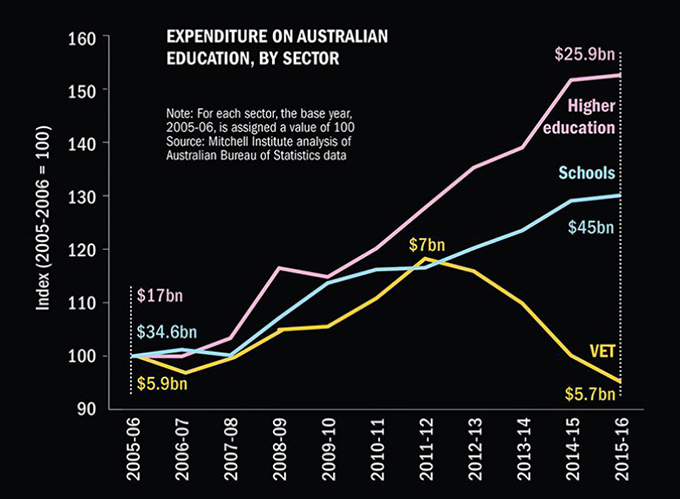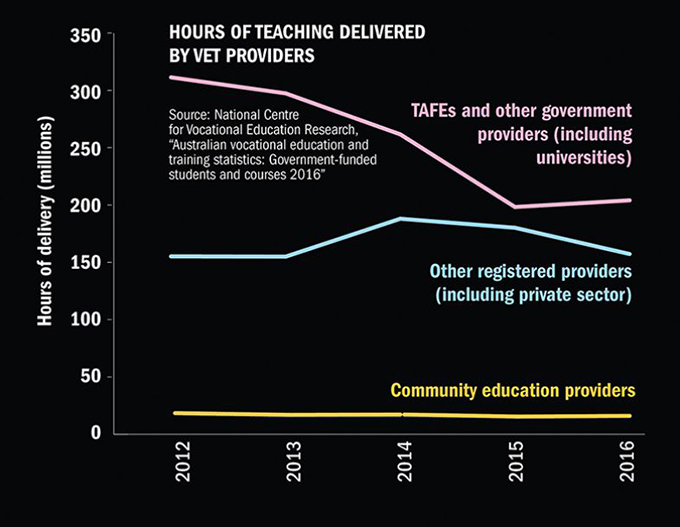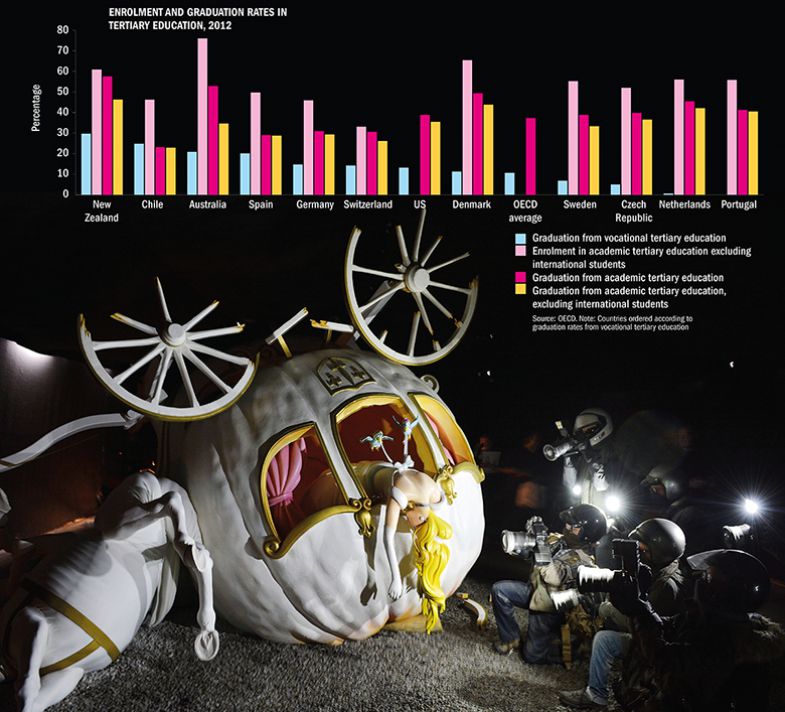 When Theresa May launched the review of English post-18 education in February, her choice of venue – a further education college in the Midlands – was no accident. The prime minister railed against an “outdated attitude” in the UK, whereby university was the “default” and “only desirable route” in tertiary education.
When Theresa May launched the review of English post-18 education in February, her choice of venue – a further education college in the Midlands – was no accident. The prime minister railed against an “outdated attitude” in the UK, whereby university was the “default” and “only desirable route” in tertiary education.
For the first time, the review would consider “the whole post-18 education sector in the round, breaking down false boundaries between further and higher education, so we can create a system which is truly joined‑up”.
There is plenty of scepticism about how far down that road the review will get – and plenty of warnings from the higher education sector that such a system should not come at the cost of reduced funding for universities. But even if nothing else changes, the recent introduction of degree apprenticeships could significantly blur the UK’s formerly hard boundaries between higher and vocational education. And the forthcoming introduction of T levels as an equal-status alternative to A levels is a further example of technical education’s rise up the political priority list in England.
It is a development that is mirrored on the other side of the globe. Australia’s Labor opposition recently announced that it would commission a similar inquiry into tertiary education if it won the next federal election. Education spokeswoman Tanya Plibersek indicated that while her review would encompass the gamut of post-school offerings, it would focus on the further education sector – known in Australia as vocational education and training, or VET – and particularly the beleaguered public technical and further education (TAFE) colleges.
The higher education sector received a thorough reappraisal from the Bradley Review in 2008, but “it’s 44 years since we’ve done a major review into TAFE”, Plibersek said in February. “We want an excellent, strong TAFE system and an excellent, strong university system…and we want TAFE and university to work better together.”
It is far from an original sentiment. The “more coherent approach” envisaged by former University of South Australia vice-chancellor Denise Bradley is one of the main pieces of unfinished work from her seminal review, which – among other things – spawned Australia’s demand-driven higher education funding system.
Bradley said that the ambitious tertiary participation targets she had prescribed would necessitate a “more holistic approach” to tertiary education planning and provision. “What is needed is a continuum of tertiary skills provision – primarily funded by a single level of government, and nationally regulated,” her report insisted.
The education minister of the time, Julia Gillard, agreed wholeheartedly. She laid plans for a “seamless” tertiary education sector with “more direct pathways” between higher education and VET, overseen by a single regulatory body.
Bradley’s wish list also included a “tertiary entitlement” funding model encompassing both higher education and VET, with income-contingent loans available to anybody studying at diploma level or above. She wanted both sectors to be served by the same ministerial council, research centre and labour market intelligence agency, with pathways between vocational and higher education enhanced by common terminology and assessment practices – at least at the upper levels of vocational study.
A decade later, none of these binding blocks is in place. Gillard’s plan to bring the two regulators together after 2013 never came about. A tertiary entitlement funding model for vocational students exists in name only, with many courses attracting no government support. An income-contingent loans scheme for diploma students was scrapped in 2016 after about A$8 billion (£4.4 billion) was squandered on largely useless courses; a far more restrictive loan programme has been installed in its place (see box below).
As a result, VET has lurched from one crisis to another. Peter Noonan, professor of tertiary education policy atVictoria University in Melbourne, has tracked the sector’s woes in a series of reports. The latest, “Expenditure on Education and Training in Australia 2017”, released last December, found that VET’s share of Australian education spending had plummeted by 30 per cent in a little over a decade. After adjusting for inflation, schools and universities had seen their revenue from government increase by 30 per cent and 52 per cent, respectively, while expenditure on vocational education had slumped by 5 per cent.
Expenditure on Australian education, by sector

Noonan, who was a member of Bradley’s review panel, says that the neglect of VET will have profound economic ramifications because much of the labour market need – according to the government’s occupational growth forecasts – will be in jobs linked directly to VET qualifications.
It is not just that VET is generally cheaper to deliver than higher education, where teaching fees and grants cross-subsidise research. Vocational training is often a better fit, with its courses calibrated to meet quality and regulatory requirements in areas such as caring for the aged, disabled and children.
“Why would you push a whole lot of people through early childhood degrees in higher education to work in an environment where a certificate is sufficient?” Noonan asks. Serious skill shortages are already emerging in the caring occupations, he adds.
While this is partly because these are not well-paid jobs, the same cannot be said of some other growth areas – such as construction and electrotechnology – where VET certificates also provide an entry ticket.
Noonan says that by underfunding VET, Australia also risks further alienating some of its most marginalised people. The sector’s personal teaching style and modest graduate outcomes are well suited to those for whom a degree and high street job seem like distant dreams. “It’s better for some people than going to uni, not doing very well, dropping out, having a debt and being adrift in the labour market,” he says.
Getting a first job – and quickly – is a crucial step for many young people, Noonan adds. Those who miss out risk being jettisoned into a vicious cycle of joblessness, poverty and single parenthood. “All the evidence suggests that the longer that gap, the less likely they’re going to participate in any further form of education,” he says. “They’re more likely to have a poor labour market experience over their lifetimes – particularly women.”
People with modest career aspirations are not the only ones who should worry about the demise of VET. Melbourne educational strategist Sean Gallagher says that higher education is losing its 50-year edge as the incubator of top-end professionals, as automation and artificial intelligence erase the need for what he calls “cognitive labour”.
Hours of teaching delivered by VET providers

Gallagher, who directs the Centre for the New Workforce at Swinburne University of Technology, says that technology is usurping “routine and predictable jobs” in areas such as law, auditing and diagnostics. The need for human workers lies increasingly in “complex and ambiguous” roles – advanced manufacturing, for example – where VET is as significant a preparatory ground as universities.
Gallagher points to three countries – the Philippines, South Korea and Germany – to highlight the importance of not only educating the populace, but getting the balance right between technical and higher education. In 1960, the gross domestic product per capita in war-ravaged South Korea was barely half that of the industrially active Philippines. Today, South Korea’s per capita GDP is about 10 times higher, thanks to an educational investment juggernaut that has produced tertiary education participation rates of about 45 per cent across the workforce, and 70 per cent among recent high school leavers. But an overwhelming focus on higher rather than vocational education means that the return from this investment is “diminishing”, Gallagher says. Meanwhile in Germany, where, according to the Organisation for Economic Cooperation and Development, only 31 per cent of the population graduate from “academically oriented tertiary programmes”, GDP per capita is about 50 per cent higher than in South Korea. In Germany, 15 per cent of young people graduate from “vocationally oriented tertiary programmes”; no figure is available for South Korea. The OECD average is 10 per cent.
A similar example is Switzerland. Its GDP per capita is nearly three times that of South Korea, and is the second highest in the world, according to the World Bank. But it sends just 28 per cent of students below the age of 25 to university: Germany sends 41 per cent but because its dropout rate is much higher, graduation rates are similar (see graph below). As Times Higher Education reported recently, most of its young people pursue a vocational path instead (“No more graduates needed: Switzerland takes its own route”, News, 25 April).
Enrolment and graduation rates in tertiary education

Gallagher stresses that he is not arguing against “too much” university education. “You should have a system that treats vocational and higher education on an equal footing, and then allow the market to determine what is going to best serve the needs of the labour market,” he says. “In Australia, vocational education is treated as the ugly sister. Increasingly, that is not fit for purpose for the economy.”
He cites rules that deny subsidised vocational training to people who already have university-level qualifications. This discourages degree-educated people from obtaining top-up training in areas such as coding and data analytics, which are now vital to many occupations. Such needs are best met through short VET courses after graduation, Gallagher says, because digital skills taught as part of three- or four-year degrees will be obsolete by the time people leave university.
“The half-life of those skills is getting shorter and shorter,” he says.

This is just one of the structural inequities that relegate TAFEs to poor cousin status. Funded by both state and federal governments – unlike universities, which receive the lion’s share of their public funding from the central government in Canberra – TAFEs lose out when governments shift costs to each other. This is especially true of state governments, which exploit new federal money as an excuse to withdraw their own spending.
VET also struggles to compete in lobbying terms. One reason is cultural: VET has long been considered a consolation prize for people lacking academic aptitude. But TAFEs also suffer structural impediments. Universities are autonomous bodies run by vice-chancellors who are not backward in coming forward with funding demands. TAFEs, by contrast, are government agencies, and their chief executives – even those heading nominally independent “statutory authorities” – avoid public statements that could embarrass their political masters. Hence, of the dozens of tertiary education changes proposed or implemented over the past decade, very few have played in VET’s favour.
Principal among these reforms was the demand-driven higher education funding system. Designed to ramp up degree-level study, it removed caps on the number of undergraduate students that universities were allowed to admit and set targets for higher education participation – particularly among the low socio-economic status groups who had traditionally shied away from university.
Handed a mandate to go forth and multiply, universities did so – mining VET’s natural constituency in the process. The charge was led by Swinburne and the multi-campus Australian Catholic University, whose vocational brand of higher education saw their domestic bachelor’s student numbers almost triple within eight years.
The Australian Education Union says that the “blurring” of the boundary between higher and vocational education, ostensibly to allow the sectors to work together more effectively, left VET vulnerable to “cannibalisation”. Students who would have previously gravitated to TAFE because it was more affordable and appropriate, found degrees becoming cheaper as the fees for diplomas skyrocketed, from about A$1,000 to A$1,500 a decade ago to perhaps 10 times as much. Many exemptions and concessions for disadvantaged people have been axed, and upper-level vocational courses in at least one state now attract no government support at all.
Reform plans hatched by the Coalition government several years ago would have increased the pain for VET colleges, by including sub-bachelor’s places in the uncapped higher education system. Although this idea was twice rejected by the Senate, so was a proposal to let vocational colleges compete as higher education providers. This disadvantaged the dozen-odd TAFEs that had developed degree programmes as a practical alternative to university. Only a handful of these degrees – those that teach skills thought to be in demand from industry – have been allowed into the demand-driven higher education system. TAFE higher education students on other courses must pay full fees – unlike their counterparts at university, where some 60 per cent of course costs are subsidised.
To add insult to injury, while TAFE degree students are eligible for income-contingent loans to cover their upfront tuition costs, they are slugged with a 25 per cent loan fee; their university peers pay no such fee.
“Parents basically said, why would you incur those sorts of costs?” says AEU deputy secretary Pat Forward.
Since the demand-driven system was unveiled in 2009, the share of domestic bachelor’s students taught by non-university providers – including TAFEs and private colleges, many of which operate in both HE and VET – has remained at about 4 per cent. But VET’s overall number of publicly funded students has plummeted by almost a quarter since 2012.
However, the different categories of providers within VET have fared quite differently. TAFEs have been hit by a series of disastrous open market experiments that, at the same time, have seen private colleges’ number of government-subsidised students more than double (see box below). TAFE enrolments have fallen by about 25 per cent since the first of these schemes emerged in 2008, resulting in numerous amalgamations and campus closures: Australia now has about 33 TAFE institutes, down from almost 60 a decade ago.

While universities have benefited from VET’s woes, they are increasingly realising that its decline is something they can no longer ignore. In December, Peter Coaldrake, the outgoing vice-chancellor of Queensland University of Technology, criticised universities for their “all about us” approach, and said that the education minister’s first priority should be “joining up” post-school learning.
In a book launched late last year, University of Melbourne vice-chancellor Glyn Davis recommended a single post-school policy perspective as the first of four initiatives to “fundamentally change public universities’ contribution to the nation”.
“There’s a lot of criticism that too many people are going to university,” Davis says. “The funding system certainly gives you an incentive to go to university. People are doing sub-bachelor’s at universities for things they might want to do in vocational education. We could make the two systems work in the interests of students so that the funding system doesn’t privilege some students over others.”
Last October, the Business Council of Australia also proposed that higher and vocational education be brought together in a single tertiary funding system. Although representative body Universities Australia rejected the idea – fearful of losing funds to the poor-cousin sector – the issue dominated its higher education conference in Canberra in February. Chairwoman Margaret Gardner, vice-chancellor of Monash University, told the conference that the time had come for a fresh look at VET, describing the cuts and damage to the sector over the past decade as a “tragedy”.
Recent events suggest that governments are taking some notice. In its May budget, Victoria invested A$172 million to eliminate fees for 30 key TAFE courses. A week later, the federal governmentearmarked an extra A$250 million for VET in a tacit acknowledgement that a A$1.5 billion skills fund announced the previous year was inadequately financed.
In his budget reply speech two days later, opposition leader Bill Shorten highlighted Labor’s plans to quarantine two-thirds of public VET funding for TAFEs, and to spend A$100 million on improving their facilities.
Applications to the VET system could be set to increase after the recently announced freeze on university teaching grants. The freeze, imposed just before Christmas, did not change most universities’ admissions plans for the beginning of the 2018 academic year. But that could change in the second semester if tight finances force them to turn away the sorts of people they had admitted under the demand-driven system.
Still, there are “real obstacles to VET coming back to life”, according to Andrew Norton, tertiary education analyst with the Grattan Institute thinktank. Chief among them, he says, is the fact that many VET diploma students are ineligible for loans and so must pay their fees up front.
The physical capacity of the VET system to absorb more students must also be open to question in light of all the closures and redundancies. However, Gallagher says that experience in both higher and vocational education has shown that the supply of places is not an issue “if the funding is there”.
The government has indicated that it intends to unfreeze university teaching grants again from 2020, but any increases will be tied to “performance targets” – most likely around completion and employment. Universities that have enrolled unsuitable students might find their attrition rates rising and their graduate employment rates falling, sabotaging their chances of securing more teaching grants and leading them to tighten up their admissions criteria. This could also result in more students enrolling in VET as their only option.
However, Gallagher points out that at Swinburne, many students successfully make the transition from VET to higher education: “On average, they’re better performers than the university students.” And Norton says that universities should be able to manage the risks by quickly expelling students who turn out to be unsuitable – ideally, before the “census date” when students start to incur debts.
“Universities could probably improve their numbers almost overnight without changing anything else,” Norton says. “All you’re doing is having students who are vulnerable never counted as enrolled. If they’re never counted as having been enrolled, they can never be counted as having dropped out.”
Whatever the implications of the funding freeze, tertiary education consultant Robert Griew says that universities will have to strike a new accord with the VET sector. Disruptive threats such as online courses and blockchain credentialing – together with widespread distrust of academics’ supposed elitism – will force them to think more broadly about their products.
Griew, a former Canberra bureaucrat who oversaw higher education, says that universities have repeatedly undermined government attempts to extend the demand-driven system to more qualifications and providers. But they will have to embrace a system with broader appeal and relevance, or risk alienating “middle Australians” from tertiary education entirely.
“I’m encouraging universities to think outside the box and forge more constructive relationships with other post-school providers,” he says, adding that this could help to secure policies geared towards growth in tertiary participation.
“I don’t think any education minister is going to win that argument without having a look at the arrangements being funded, and the different levels and options,” he says. “Education ministers can’t take higher education products as a complete given. My message to universities is that they shouldn’t, either.”
Boondoggles and bloat: a costly failure to learn lessons in market push
The demand-driven system has exposed Australia’s universities to increased competition, but nothing like the free-for-all that colleges in its technical and further education (TAFE) sector have had to contend with.
For a start, the 125 or so non-university providers of degrees, which include about a dozen TAFEs, were almost completely excluded from the publicly funded higher education system. By contrast, many of the 4,500-odd non-TAFE vocational providers – mostly private colleges of various kinds – have enjoyed untrammelled access to public vocational education and training (VET) funding.
Policies that would never have been allowed in higher education were routinely applied in VET. Unlike universities, for example, vocational colleges were often allowed to set their own fees. And oversight remained lax even when the government in effect became guarantor by allowing students to defer fees for some courses through income-contingent loans – opening the door for colleges to trumpet that their expensive courses had “no upfront fees”.
Regulators didn’t blink when a private college suddenly started charging A$22,000 (£12,350) for a web design diploma that cost about A$4,500 elsewhere, or when a competitor’s student population snowballed from about 300 one year to almost 12,000 the next.
The light regulatory touch encouraged scores of scams, known in Australian parlance as “rorts”, as unscrupulous colleges pushed the rules to the fringes of criminality. In one infamous case, a Melbourne college awarded football club members certificates in outdoor recreation for a few nights of “learning” on their own premises. It gave participants and their clubs A$1,500 kickbacks, bankrolled from state government subsidies worth up to A$5,000 per student, and called them “scholarships”.
In another case, the directors of a soon-to-be-bankrupt college paid their shareholders – including themselves – A$15 million in dividends, on the same day that Australia’s consumer watchdog launched proceedings to recover tens of millions of dollars in improperly obtained student loans. The company subsequently collapsed with unpaid debts of about A$80 million, having swallowed A$222 million in loans.
Similar stories have been emerging for years, as governments and bureaucrats – driven by an unswerving faith in the market, together with a desire to cut their reliance on TAFEs and their expensive teachers – resolutely failed to learn from each other’s mistakes.
The federal government’s Productivity Places Program, launched in 2008, was intended to shake up TAFEs by offering private colleges funding on an equal footing. Instead, it was monopolised by private providers maximising their profits by running cheap-to-teach courses in security and sales, while the real need was in areas such as aged care and health. A mid-term review found that the A$2.1 billion scheme had been so badly administered that evaluators could not tell how many people had participated. It was eventually scrapped halfway through what was supposed to be a five-year term.
Yet the PPP became the prototype for a string of failed state schemes. The Victorian Training Guarantee was cut back savagely in 2012 after the state’s training budget inflated by A$400 million. South Australia’s Skills for All was subjected to constant tinkering and eventually axed after a similar overspend.
The most catastrophic of the open market programmes was the federal government’s VET FEE‑HELP loans scheme, which grew exponentially after the rules were relaxed in 2012. Its poor design and cursory oversight saw allocations mushroom from a little over A$300 million in 2012 to A$2.9 billion in 2015, before it was finally pared back and then replaced.
Some A$8 billion was squandered this way, and the government has already formally written off A$2 billion of that. This was a significant factor in the federal government’s decision to curtail loans to all students, including university students. A bill now before parliament seeks to limit the amount they can borrow, and to force them to repay earlier.
The money lavished on VET FEE‑HELP and the other debacles is now lost to the vocational sector. The cumulative effects of starvation funding, together with a now-pedantic regulatory zeal, were illustrated late last year when South Australia’s public training provider, TAFE SA, comprehensively failed a random audit.
The Australian Skills Quality Authority, which regulates most of Australia’s vocational colleges, has only recently revoked a long-standing threat to cancel TAFE SA’s authority to offer at least 10 courses. Ominously, the authority says that performance at other states’ TAFEs is likely to be worse. While 67 per cent of its audits of TAFE SA activities have revealed problems, the “noncompliance” rate across Australia’s other TAFEs is an extraordinary 80 per cent, it says.
Author Bio: John Ross, Editor Times Higher Education
